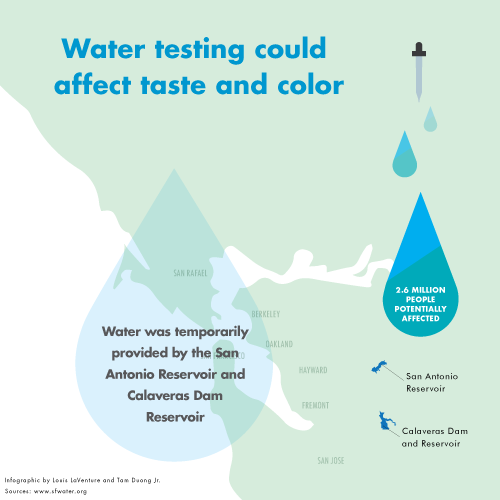Water testing could affect taste and color

INFOGRAPHIC BY TAM DUONG JR/THE PIONEER
October 22, 2015
If East Bay residents think their water looks and tastes funny, they might be right.
Last week the San Francisco Public Utilities Commission began testing a backup water supply that is designed to provide water to Bay Area residents, including many East Bay cities. The Lower Cherry Aqueduct System was damaged in the Stanislaus National Forest Rim Fire of 2013, but was recently repaired by the SFPUC. They began testing the repairs Oct. 16 and will continue until Nov. 16, according to East Bay Municipal Utility District Public Information Representative Tracie Morales.
On Oct. 14, the SFPUC issued a statement that said East Bay residents could experience “discolored or foul tasting” water during the test period. Normally these residents receive their water from the Hetch Hetchy Water System located in Yosemite National Park, but a mix of different water sources will service East Bay residents in the interim. From Oct. 14-16, the SFPUC provided water to its customers from multiple sources that included two Alameda County reservoirs: Calaveras and San Antonio.
Morales said the water could be unfamiliar looking and tasting to customers, but will still meet all federal and state water quality requirements
Morales said the water could be unfamiliar looking and tasting to customers, but will still meet all federal and state water quality requirements.
CSUEB professor Michael D. Lee is in the department of anthropology, geography and environmental studies, as well as the Faculty in Residence for Sustainability and Pedagogy for the campus and confirmed that no matter what the water looks or smells like, it will still be fine to drink.
He further explained that in order to test and provide water to its customers without wasting it, the SFPUC will blend the Hetch Hetchy water with other sources.
“But the Lower Cherry Reservoir water is of a somewhat lower ambient quality,” Lee said. “So it needs to be treated more thoroughly and thus may have a slightly different taste and appearance.”
According to the SFPUC press release, the Lower Cherry Aqueduct System has not been used since 1988 and was already damaged before the fire in 2013.
The East Bay water supply is minimally treated, according to Lee. However, a higher presence of bacteria and algae due to low water levels and high temperatures caused by the drought have had an effect on the color and taste.
According to the SFPUC website, they provide water to more than 2.6 million people throughout the Bay Area. Since the normal water supply does not require extra treatment, there will be a change in the process. Until Nov. 16, the water will be treated and processed at the Sunol Valley Water Treatment Plant and then make its way to residents.
“SFPUC supplies water as a wholesaler to many East Bay, South Bay and Peninsula communities as well as the City and County of San Francisco itself,” Lee continued. “It is undertaking a massive rehabilitation of its water storage and conveyance system over the coming decade to address age and seismic safety concerns.”
Lee was referring to the potential damage that could be caused to the water system by an earthquake. According to Susan Garcia, a United States Geological Survey Earthquake Science Center representative, any seismic activity could potentially damage any water systems that are not retrofitted to sustain an earthquake.
Morales confirmed that Hayward residents could be one of the populations affected by the water testing. The SFPUC did not respond to The Pioneer at the time of publication.















